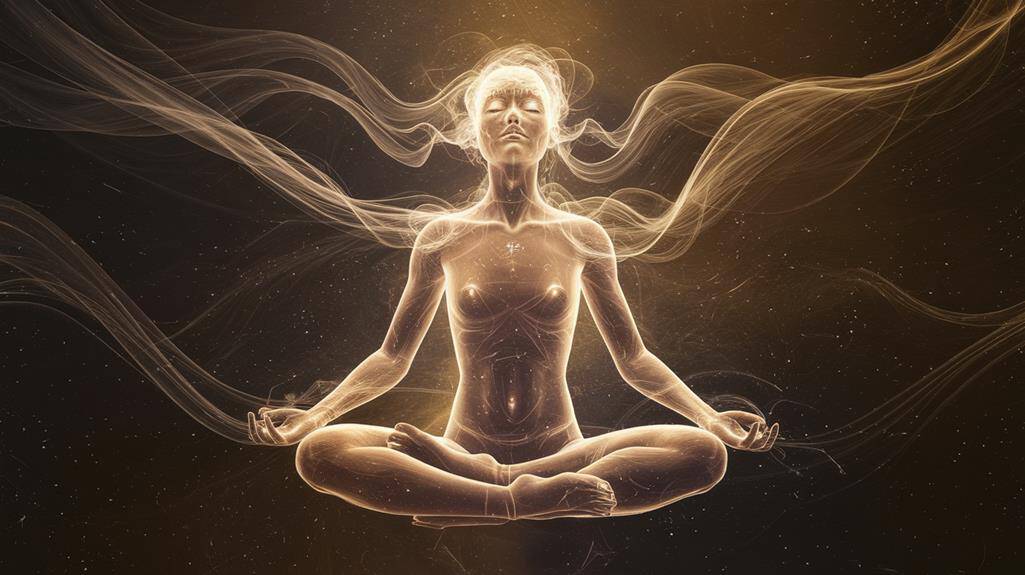The Role of Fasting in Mystical Practices
You’ve likely heard of religious fasting, but you may not realize its profound connection to mystical experiences throughout human history. When you deny your body food, you’ll find that something extraordinary begins to happen: your consciousness shifts, your perception sharpens, and the veil between the physical and spiritual worlds grows thinner. This isn’t merely ancient folklore—it’s a documented phenomenon that spans cultures and continents, from Buddhist monasteries to Native American vision quests. The practice of sacred fasting holds secrets that modern seekers still haven’t fully uncovered, and its power to transform consciousness remains one of spirituality’s most intriguing mysteries.
Ancient Origins of Sacred Fasting

Fasting as a spiritual practice dates back to the earliest human civilizations, emerging independently across cultures from Egypt to India around 3000 BCE.
You’ll find that ancient mystics discovered how voluntary hunger could transport your consciousness beyond ordinary awareness, opening doorways to transcendent domains that weren’t accessible in states of physical satiation.
These wisdom keepers understood that when you deny the body’s basic needs, you’re able to break free from material attachments and glimpse profound spiritual truths.
In the temples of ancient Egypt, you’d have witnessed initiates undertaking long periods of fasting before participating in sacred mysteries, while halfway across the world, shamanic traditions employed food restriction as a gateway to altered states and divine communion.
You’ll discover that these practices weren’t merely about physical deprivation – they represented a deliberate choosing of spirit over matter, consciousness over comfort.
When you study the archaeological evidence, you’ll see how fasting rituals were often depicted in sacred art and texts, suggesting that our ancestors understood the profound connection between emptying the body and filling the soul.
Fasting in World Religions
These ancient fasting practices evolved into formalized spiritual disciplines within the world’s major religions.
You’ll find that in Buddhism, monks and laypeople alike engage in mindful fasting to cultivate clarity and detachment from physical desires.
In Islam, you’re called to observe Ramadan, where fasting from dawn to dusk isn’t just about abstaining from food – it’s a profound journey of spiritual purification and communal solidarity.
Christianity’s tradition invites you to fast during Lent, mirroring Christ’s forty days in the desert, while in Judaism, you’ll encounter multiple fasting days, with Yom Kippur standing as the most sacred time of complete abstention.
In Hinduism, you’re encouraged to practice periodic fasting on specific days aligned with lunar cycles and deities, each fast carrying its own spiritual significance and transformative potential.
You’ll discover that across these traditions, fasting isn’t merely about denying yourself sustenance – it’s about opening channels to deeper spiritual awareness.
Whether you’re seeking enlightenment, atonement, or divine connection, these practices offer you pathways to transcend physical limitations and access heightened states of consciousness through disciplined abstinence.
Mind-Body Connection During Fasting

When you engage in extended periods without food, your body initiates profound changes that directly influence your mental state. You’ll notice a heightened sense of awareness emerging as your system shifts from its usual metabolic patterns, creating space for deeper contemplation and altered consciousness.
Within this transformative state, you’re likely to experience a dissolution of ordinary mental boundaries, allowing previously hidden insights to surface with remarkable clarity.
As your fast deepens, you’ll discover that the traditional barriers between physical sensation and spiritual awareness begin to blur. Your consciousness expands beyond your body’s immediate needs, and you’ll find yourself attuned to subtle energetic shifts that you might typically overlook in your daily existence.
This mind-body synthesis isn’t merely a biological response – it’s a gateway to transcendent experiences that mystics have accessed throughout history. You’re participating in an ancient practice that allows you to witness the intricate dance between your physical form and consciousness, revealing how these seemingly separate aspects of your being are profoundly interconnected.
Through this process, you’re able to access states of consciousness that transcend ordinary perception.
Vision Quests and Wilderness Solitude
Vision quests in untamed wilderness settings magnify the transformative power of fasting by removing everyday distractions and deepening your connection to the natural world. As you venture into remote landscapes, you’ll find that hunger sharpens your senses while solitude strips away society’s constant noise, leaving you face-to-face with your innermost truths.
In these sacred wilderness spaces, you’re called to embrace discomfort as your teacher. The elements become your companions – wind whispers ancient wisdom, while stars guide your nocturnal contemplations. Time shifts its meaning when you’re alone with your thoughts, and the rhythms of nature begin to sync with your body’s own cycles of hunger and rest.
Your vision quest isn’t just about abstaining from food; it’s about creating space for profound revelations to emerge. As physical hunger subsides, you’ll notice subtle energies and insights that typically remain hidden beneath daily concerns.
The wilderness mirrors your internal landscape, challenging you to face your fears while offering the raw materials for transformation. Through this intentional merging of fasting and isolation, you’re participating in a timeless tradition that’s helped seekers access deeper dimensions of consciousness.
Spiritual Cleansing Through Abstinence

Through spiritual traditions worldwide, fasting serves as a powerful method of inner purification that extends far beyond physical detoxification. When you consciously choose to abstain from food, you’ll find yourself entering a profound state of clarity where the mundane falls away, revealing deeper spiritual truths that often remain hidden in your daily life.
This deliberate emptying creates space for divine connection and inner transformation.
You’ll discover that spiritual cleansing through fasting isn’t merely about denying yourself sustenance – it’s about releasing attachments that bind you to material existence. As your body gradually detaches from physical cravings, you’ll notice your consciousness expanding, allowing you to perceive subtle energies and insights that typically elude your awareness.
The practice draws you into a sacred space where you’re able to confront your shadows, release emotional baggage, and reconnect with your essential nature.
Your journey through abstinence becomes a pathway to freedom, where each hunger pang serves as a reminder of your commitment to spiritual growth. In this emptiness, you’ll paradoxically find fullness – a profound connection to the infinite that transcends physical limitations.
Fasting Rituals Across Cultures
From ancient temples to modern monasteries, diverse cultures have developed distinct fasting rituals that reflect their unique spiritual philosophies and social customs.
You’ll find Buddhist monks embracing their daily fast after noon, while Sufi mystics pursue their forty-day retreats of minimal sustenance. Each tradition carries its own sacred timing and precise methods that you’re invited to understand and respect.
In Native American vision quests, you’ll discover how seeking spirits through hunger creates a bridge between physical and supernatural domains, while Islamic Ramadan teaches you to transcend bodily needs from dawn to dusk.
These practices aren’t merely about abstaining from food – they’re gateways to altered states of consciousness that you can access through disciplined devotion.
When you examine Orthodox Christian traditions, you’ll notice how their multiple fasting periods align with celestial cycles and biblical events.
Meanwhile, Hindu ascetics demonstrate how you can maintain extended fasts as pathways to enlightenment.
Whether you’re drawn to the structured approach of organized religion or the solitary path of personal mysticism, you’ll find that fasting rituals offer transformative experiences that transcend cultural boundaries.
Altered States and Divine Communication

Many mystics throughout history have reported profound alterations in consciousness during extended fasts, claiming these states enable direct divine communication.
You’ll find that as your body adapts to the absence of food, your awareness often shifts dramatically, opening doorways to heightened spiritual sensitivity that you might never experience in ordinary states. When you’re fasting, the veil between physical and spiritual dimensions can become remarkably thin.
You’ll discover that prolonged fasting creates distinct neurochemical changes that affect your perception and cognitive processes. Your brain’s usual patterns begin to shift, and you’ll notice an increasing detachment from ordinary sensory experiences.
This altered state isn’t merely about physical deprivation – it’s a gateway that mystics have long used to transcend normal consciousness. You’re likely to experience vivid dreams, spontaneous insights, and what many describe as direct spiritual messages.
The physical lightness you’ll feel often translates into psychological clarity, allowing you to perceive subtle energies and communications that normally remain hidden beneath the noise of daily life and physical needs.
Modern Mystical Fasting Practices
Contemporary practitioners have adapted ancient fasting traditions to fit within modern spiritual frameworks, integrating scientific understanding with mystical objectives. You’ll find that today’s seekers often combine intermittent fasting with meditation, creating personalized rhythms that honor both bodily wisdom and spiritual aspirations.
These practices reflect a sophisticated synthesis of time-tested methods and contemporary lifestyle demands. As you explore modern mystical fasting, you’ll discover how practitioners interweave traditional elements with current wellness approaches.
You might encounter water fasting retreats that incorporate digital detoxes, or sunrise-to-sunset fasts paired with mindfulness apps. Within these evolving frameworks, you’ll notice how the ancient pursuit of transcendence adapts to your modern context while preserving its essential transformative power.
In your journey, you’ll find that contemporary mystical fasting often emphasizes community support through online forums and virtual gatherings, where practitioners share insights and experiences.
This digital connection doesn’t diminish the profound solitude of your fast; rather, it creates a bridge between ancient wisdom and modern fellowship, allowing you to access deeper states of consciousness while remaining grounded in present-day reality.
Physical Effects on Consciousness

Through sustained periods of fasting, your brain chemistry undergoes significant changes that can alter consciousness and perception. As your body depletes its glucose reserves, you’ll notice a heightened sensitivity to your surroundings and a sharpening of mental clarity that transcends ordinary awareness.
Your brain begins producing ketones, which can trigger states of consciousness remarkably similar to those achieved through deep meditation. During extended fasts, you’ll discover that your mind enters domains of perception that aren’t accessible in your normal fed state.
The reduction in digestive demands allows your body to redirect energy toward neural processes, potentially awakening dormant capacities for insight and intuition. You’ll find yourself experiencing time differently – moments stretch longer, and your attention naturally draws inward.
The physical sensation of hunger gradually transforms into a peculiar lightness, as if you’re floating above your ordinary concerns. The biochemical shifts in your brain can induce naturally occurring compounds that parallel mystical experiences, opening doorways to expanded states of awareness.
Your consciousness becomes more fluid, less bound by habitual patterns, allowing you to access deeper layers of understanding and connection.
Transformative Power of Hunger
Hunger’s grip on the human psyche extends far beyond mere physical discomfort, acting as a catalyst for profound personal transformation. As you deny your body sustenance, you’ll discover that your awareness begins to shift, peeling away layers of mundane concerns to reveal deeper truths that often remain hidden in your daily routine.
Your heightened sensitivity can open doorways to altered states of consciousness, where you’ll find yourself more attuned to subtle energies and spiritual insights.
When you embrace voluntary hunger, you’re participating in an ancient practice that mystics have long recognized as a path to transcendence. You’ll notice how your thoughts become sharper, more focused, as your body draws inward and your spirit reaches outward.
The emptiness in your stomach creates a sacred space where you can confront your attachments and dependencies, learning to distinguish between genuine needs and conditioned desires.
Through this process, you’re not just denying yourself food; you’re actively engaging in a practice that has the power to reshape your relationship with both the material and spiritual worlds, leading to profound revelations about your true nature.









